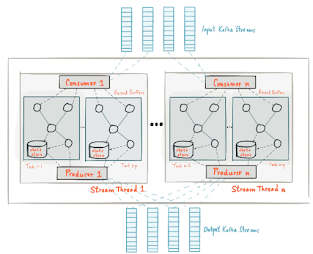Secure Handling of PCI and PII Data during Data Ingestion to Data Lakes
As enterprises increasingly migrate their analytical
workload and storage to cloud data lakes (AWS S3, Google Cloud Storage, Azure
ADLS), managing sensitive data such as Payment Card Information (PCI), PHI
and Personally Identifiable Information (PII) becomes crucial. Apache Kafka
Streams, a lightweight and distributed stream processing library, offers
robust capabilities to process data in motion. This article discusses how Kafka
Streams can be exploited to handle PCI and PII data securely during data
ingestion into data lakes. We explore design patterns, best practices, and
regulatory compliance mechanisms, focusing on data encryption, masking, and
governance.
The challenge in Ingesting Sensitive Data to Data Lake
Data lakes serve as centralized repositories for storing
vast amounts of structured, semi-structured, and unstructured data. While they
offer immense flexibility for analytics and storage, the ingestion of sensitive
data such as PCI and PII requires stringent security and compliance measures.
Apache Kafka Streams provides a powerful tool for stream processing, enabling
real-time transformation, enrichment, and secure handling of sensitive data
during ingestion.
Complexities in Handling PCI and PII Data
- Regulatory
Compliance: PCI data is governed by the Payment Card Industry Data
Security Standard (PCI DSS). PII falls under various regulatory
frameworks such as GDPR, CCPA, and HIPAA.
- Security
Risks: Data breaches during transmission or storage. Unauthorized
access to sensitive information.
- Data
Transformation: Ensuring sensitive data is masked, tokenized, or
encrypted before landing in the data lake.
- Scalability:
Efficiently processing high-velocity streams without compromising
security.
Kafka Streams Overview
Kafka Streams is a lightweight Java library for building
real-time, distributed stream processing applications directly on Apache Kafka.
Builds on the Apache Kafka® producer and consumer APIs, and leverages the
native capabilities of Kafka to offer data parallelism, distributed
coordination, fault tolerance, and operational simplicity. Hence it processes
and transforms data streams from Kafka topics with scalability, fault
tolerance, and exactly-once semantics. It includes a high-level DSL, support
for stateful and stateless operations, embedded state stores, and integration
with Kafka. The typical use cases for Kafka Streams are real-time analytics,
event-driven applications, data transformation, and monitoring. Unlike
other frameworks like Spark streaming and Flink, it requires no separate
cluster, running as part of the application itself.
Kafka Stream Architecture
Securing PCI and PII Data with Kafka Streams
To secure PCI and PII data using Kafka Streams, sensitive
fields can be encrypted, masked, tokenized, or removed using stream processing
in a stream processor (node) after reading these from a source Kafka
topic using a source processor before writing to target topics using a sink
processor.
1. Data Encryption
Encrypt sensitive data fields using cryptographic
libraries such as BouncyCastle or Java Cryptography Extension (JCE) within Kafka
Streams processors. This encryption can be applied at the field level to
isolate and protect PCI and PII fields, using mapValues() or process() methods.
Encryption keys are stored securely using key management systems (e.g., AWS
KMS, HashiCorp Vault).
2. Data Masking and Tokenization
Data masking and tokenization secure PCI and PII data in
Kafka Streams by transforming sensitive information into protected forms. Data
masking obscures sensitive data (e.g., replacing parts of credit card
numbers with asterisks) to prevent unauthorized access. Tokenization replaces
sensitive fields with unique tokens, storing the original data securely in a
token vault. These techniques can be implemented during stream processing to
ensure only masked or tokenized data is written to Kafka topics. This minimizes
the risk of exposing sensitive information while maintaining data usability for
downstream applications.
Kafka Stream Interceptor Architecture to handle PII / PCI
Conclusion
Apache Kafka Streams provides a versatile and secure
framework for handling PCI and PII data during ingestion into data lakes. By
leveraging encryption, masking, tokenization, and removal, organizations can
achieve regulatory compliance and safeguard sensitive information. Implementing
these best practices within Kafka Streams workflows ensures secure, scalable,
and efficient data processing, making it an essential component of modern data
pipelines.







No comments:
Post a Comment